(Caption: The Kearsney Stitchers (left to right): Rosie James, Pauline Danson, Wendy Ward, Susanne Leggatt, Bev Williams)
Textiles explore rich seam of history at Kearsney Parks
Five finely decorated textile panels inspired by two of Dover’s best-loved public parks have taken pride of place in the Kearsney Abbey café which is due to open this summer.
The stitched panels adorn the oak-panelled interior of the Grade II Listed former billiards room, which has been restored as part of the £3.1m Lottery funded Kearsney Parks project.
The sole surviving part of the grand country house which once stood on the site, the billiards room serves both as an extension to the new café and is also available for community hire.
The textiles were designed and created by the ‘Kearsney Stitchers’ a group of textile enthusiasts. Local residents Pauline Danson, Susanne Leggatt, Wendy Ward, and Bev Williams, along with professional textile artist, Rosie James, spent 1,500 hours over five years to create the unique panels using a variety of techniques.
The group took their inspiration for their designs from old photographs of Kearsney Abbey and Kearsney Court (now known as Russell Gardens), along with the people who lived and worked on the once grand country estates before they became public parks.
Postcards and tea towels featuring the textiles will be on sale at the Kearsney Café with all sales from merchandise, food and drinks being reinvested in the upkeep of the parks.
Cllr Oliver Richardson, Dover District Council’s cabinet member with responsibility for public parks, said: “We’re grateful to the Kearsney Stitchers for their hours of painstaking work to create these wonderful textiles which take pride of place in the restored billiards room.
“Alongside the restoration works, the Kearsney Stitchers have created a unique way in which to bring the heritage, flora and fauna of the parks to a wider audience.”
Bev Williams of the Kearsney Stitchers, said: “It’s fantastic to see our stitched panels in the billiards room at Kearsney Abbey. The project has been a real labour of love and brought us together as a group over the last five years.
“The stories stitched into the panels are a fitting tribute to the incredible project to bring the history of the Kearsney Parks alive. Several members of the group have welcomed new grandchildren over the past three years so the panels will be a great way to tell the next generation about the history of these wonderful public parks!”
Note to editors:
About the five textile panels at the Kearsney Abbey café:
The Barlow Panel by Bev Williams
The Barlow family lived at Kearsney Court from 1901 to 1912. Edward Barlow was Chairman of Wiggins Teape, the papermakers, and his wife Alice was President of the Dover Women’s Suffrage Society.
Bev’s textile panel was inspired by a collection of original photographs of the Barlow family collated by the late Ralph Harding, who lived at Kearsney Court and who shared his interest in preserving the gardens with the Kearsney Parks project team. The Harding Archive is available on the Kearsney Parks website offering a wonderful insight into Edwardian life.
Created to represent a page in a photograph album, the panel was machine stitched using thread to outline or make a feature of the people, garden, and the family car. Different thicknesses of threads were used, along with appliqué, beading, digitally printed photographs, and colourfast inks. Buttons and antique lace were used for Edward and Alice Barlow.
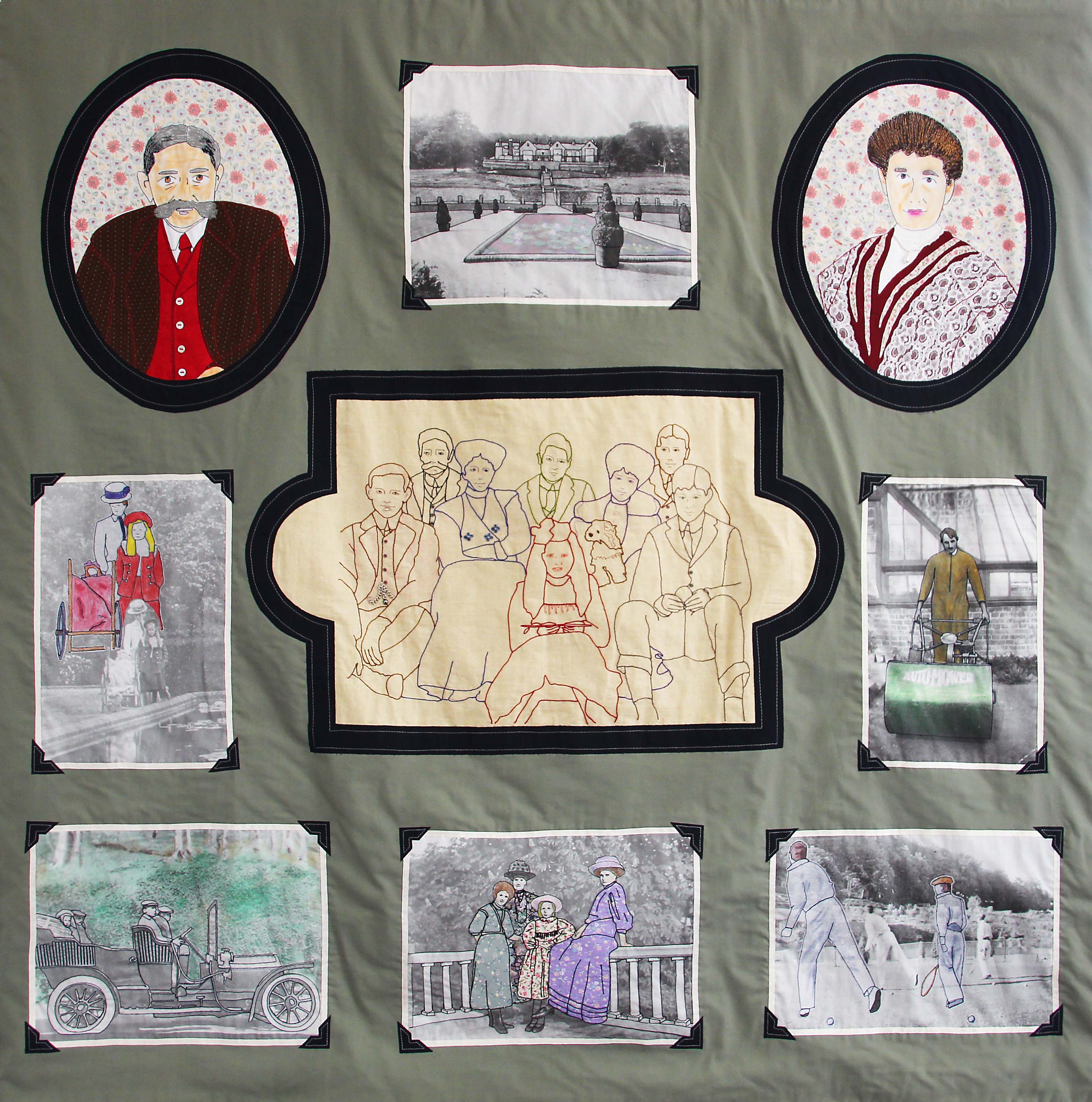
The Flora and Fauna Panel by Pauline Danson
Pauline’s family lived next to Kearsney Abbey for 60 years and her parents instilled in her a love of the natural world. Representing the plants and animals that inhabit the parks, this panel is based on one of the paths from the design of Russell Gardens. The lake and parkland of Kearsney Abbey are also represented, with the iconic Cedar of Lebanon tree taking centre stage.
The background was created from dyed fabric, printed photographs, and machine embroidery. The birds and squirrel were hand stitched using the silk shading method, then appliquéd to the background. The butterflies, insects and flowers were stitched straight on to the backing. A combination of machine and hand stitching was used with a variety of stitches.
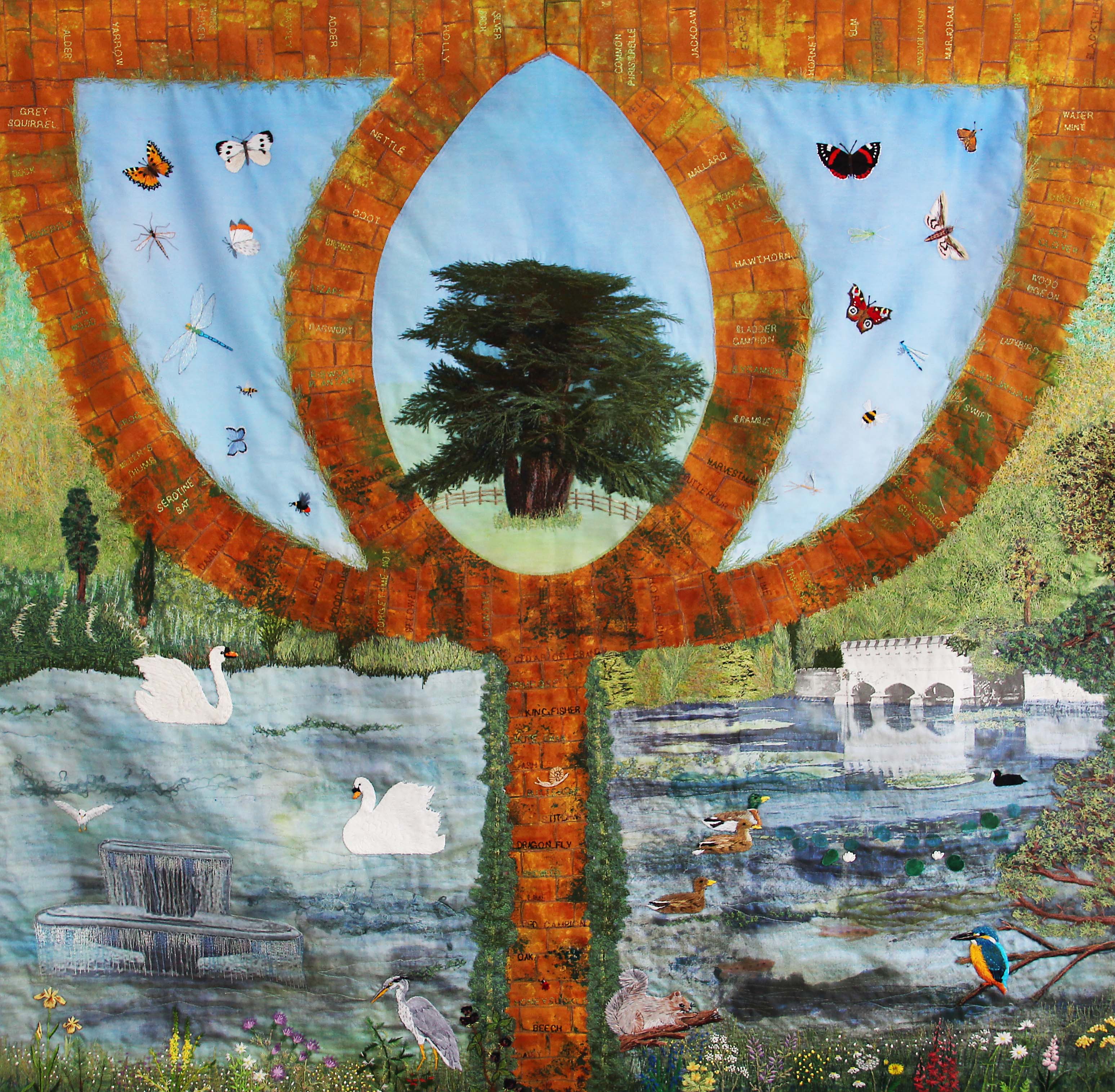
The Architecture Panel by Rosie James
Buildings and architectural features in the parks are the focus of Rosie’s panel, taking its inspiration from photographs in the Harding Archive, as well as historic documents including the conditions of sale of the Kearsney Abbey estate from 1907.
The piece consists of 12 circles within squares in a blue and white colour scheme, to represent plates on a tablecloth. Each circle zooms in on a detail of the buildings, bridges, or furniture on the panel. Parts of the inventory or sale lists were printed onto fabric and some of the furniture machine stitched on top.
Silhouettes of figures appear here and there as well as machine-stitched ladies walking around the grounds. The distinctive tower of Kearsney Court stands out as a woman in yellow walks towards it. Elements were machine-stitched, leaving loose threads here and there to create a scribbly quality and to emphasise the fact that the work is stitched.
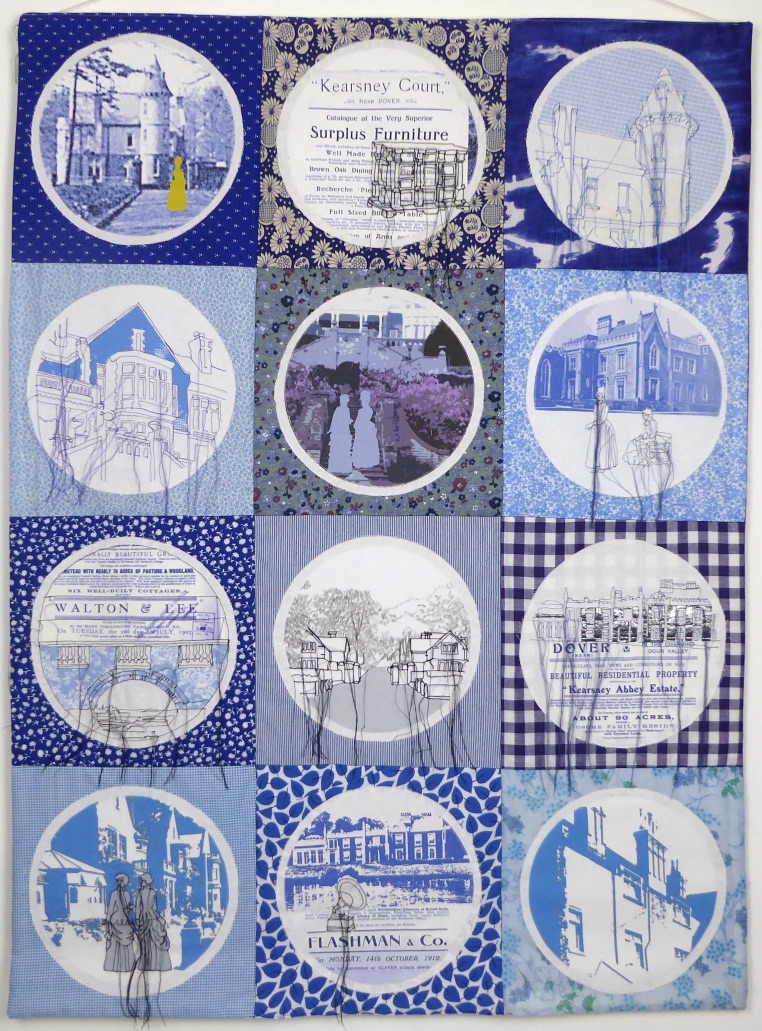
The Garden Panel by Wendy Ward
Wendy’s panel takes its inspiration from Thomas Mawson’s original landscape for Kearsney Court Gardens and shows his signature features with gardens laid out in a formal, symmetrical style, with a large semi-circular rose garden and central fountain, a lily pond and a 170m long lake edged by banks of shrubs. There were croquet and tennis lawns and a variety of trees planted in groups. Today, the gardens are Grade II Listed in the Historic England Register of Parks and Gardens.
The panel was constructed on linen using appliqué, machine, and hand embroidery with added beading. Dye was also used on silk organza and cotton. The tennis players were digitally printed onto fabric and then appliquéd to the background.
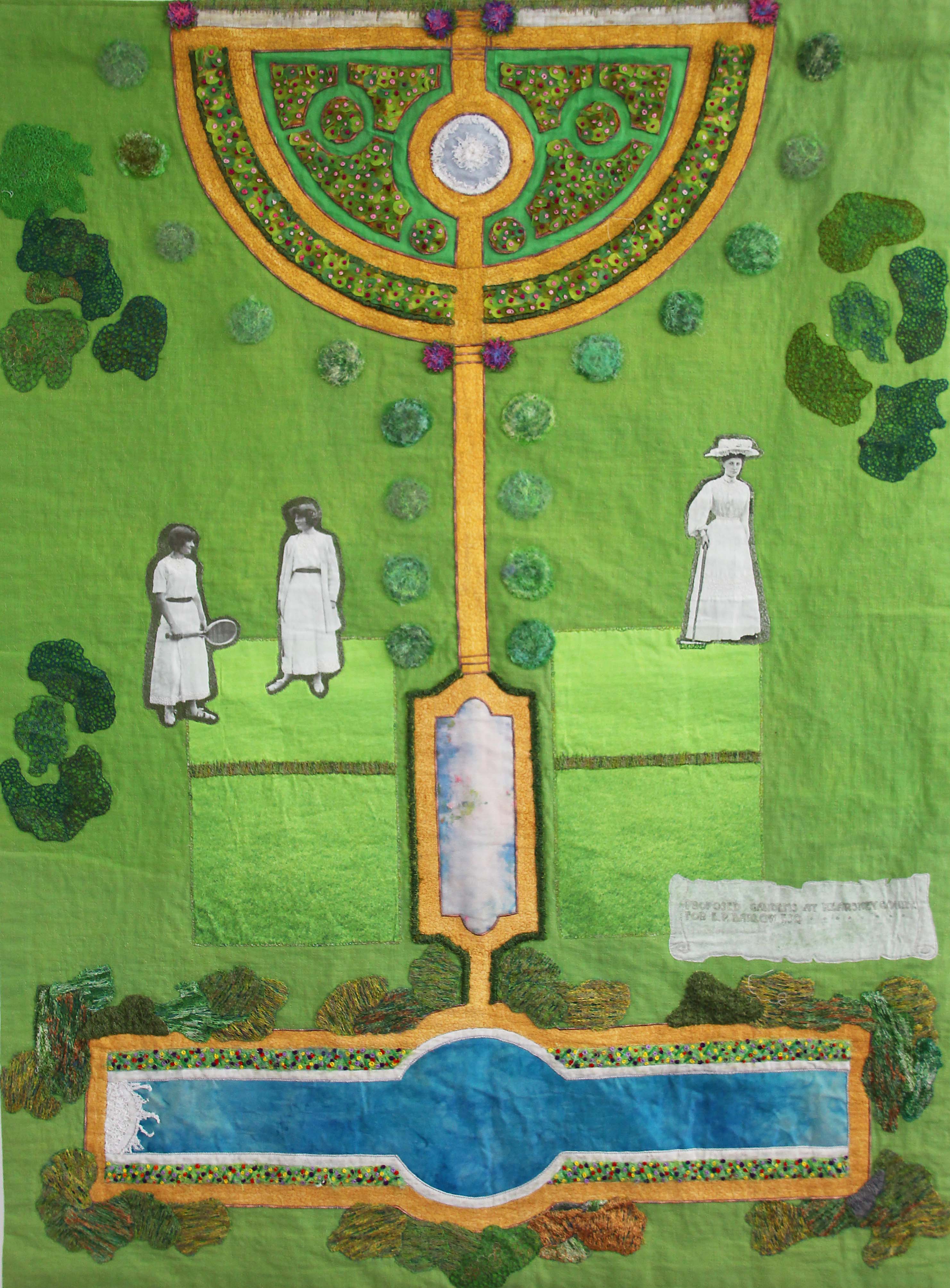
The Industry Panel by Susanne Leggatt
Susanne’s panel focuses on the mills powered by the River Dour, a rare chalk stream that flows through both parks. At one stage there were 13 paper and corn mills along the river, with Dover having the first recorded mill in Britain (c. 762AD). The mills helped to create the wealth of the businessmen who created their country estates at Kearsney Court, including Edward Barlow, and local brewer, Alfred Leney.
The panel features a map dated around 1816 and is quartered by images of four mills, including Buckland Paper Mill, with its iconic clock tower and a 1770 image of an earlier mill which once stood on the site. Top right shows Kingsford Windmill Brewery (c. 1800). Bottom right shows the remains of River Paper Mill, now a haven for wildlife in the grounds of Kearsney Abbey, and Crabble Corn Mill (1812), with its magnificent water wheel, one of the best preserved and working Georgian watermills in Europe.
The panel was created using several different techniques, including the use of applique, dyeing and printing fabric, painting onto printed photographs along with dyeing and needle felting wool. All of these were combined with free machine embroidery to add detail and texture.
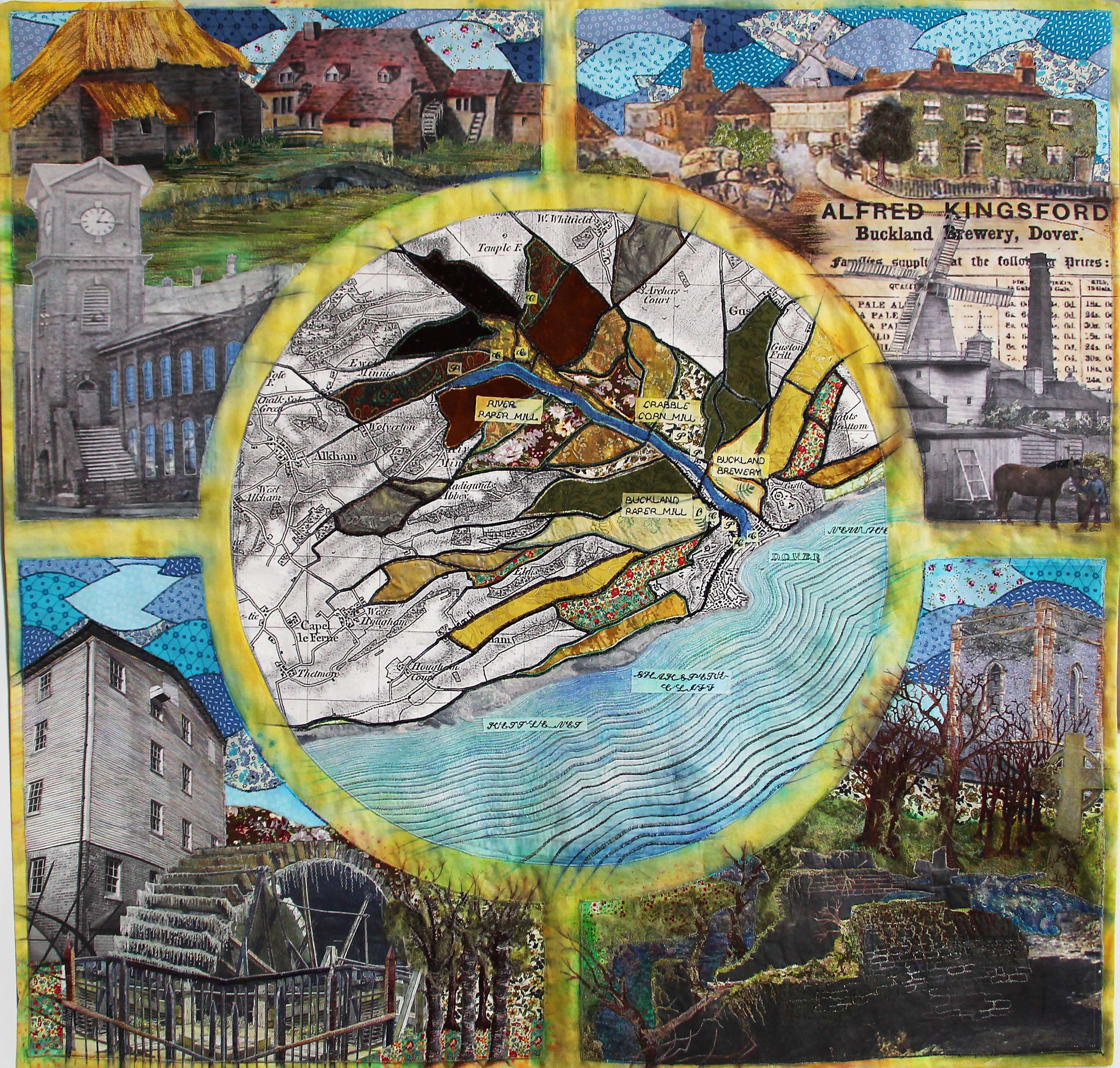
Posted on 25 May 2021